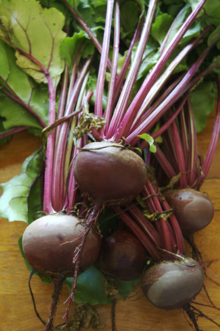**Etymology and History:**
– The name “beetroot” comes from the Latin word “beta” and Old English “bete,” while “root” originates from Old Norse “rót.”
– Beetroot was domesticated in the ancient Middle East for greens and roots by civilizations like the Ancient Egyptians, Greeks, and Romans.
– In the Middle Ages, it was used medicinally for digestive and blood-related issues.
– In the 17th century, beetroot juice was used to color wine.
– Post-World War I food shortages led to cases of ‘mangelwurzel disease’ due to excessive beetroot consumption.
**Culinary Uses:**
– Beetroot is rich in nutrients like vitamins A, C, iron, and potassium.
– It can be consumed boiled, roasted, or raw, alone or in salads, with both roots and greens being edible.
– Pickled beetroot is a traditional food in many countries.
– In Australia and New Zealand, sliced pickled beetroot is a common ingredient in traditional hamburgers.
– Eastern Europe uses beetroot in soups like borscht and as a condiment with horseradish.
**Industrial Production and Other Uses:**
– Commercial production involves processing beetroot into boiled, sterilized forms, or pickles.
– Betanin extracted from beetroot is used as a food colorant.
– Beetroot juice is stable in low-water content foods like frozen novelties.
– Beetroot can be used to make wine.
**Nutritional Information:**
– Beetroot is mostly water with carbohydrates, protein, and minimal fat.
– It is a rich source of folate and a moderate source of manganese.
– A 100g serving provides 180 kilojoules (43 kilocalories) of energy.
– Consuming beetroot juice has been reported to modestly reduce systolic blood pressure.
**Cultivars and Culinary Uses:**
– Cultivars like Action, Albino, Alto, Bettollo, and Boltardy have specific characteristics.
– Beetroot is used in various culinary dishes like borscht, roasted beetroot, Chioggia Beet Tart, and pickled beetroot.
The beetroot is the taproot portion of a beet plant, usually known in North America as beets while the vegetable is referred to as beetroot in British English, and also known as the table beet, garden beet, red beet, dinner beet or golden beet.
| Beetroot | |
|---|---|
 Beetroots on the stem | |
| Species | Beta vulgaris |
| Subspecies | Beta vulgaris subsp. vulgaris |
| Cultivar group | Conditiva Group |
| Origin | Sea beet (Beta vulgaris subsp. maritima) |
| Cultivar group members | Many; see text. |
It is one of several cultivated varieties of Beta vulgaris grown for their edible taproots and leaves (called beet greens); they have been classified as B. vulgaris subsp. vulgaris Conditiva Group.
Other cultivars of the same species include the sugar beet, the leaf vegetable known as chard or spinach beet, and mangelwurzel, which is a fodder crop. Three subspecies are typically recognized.
